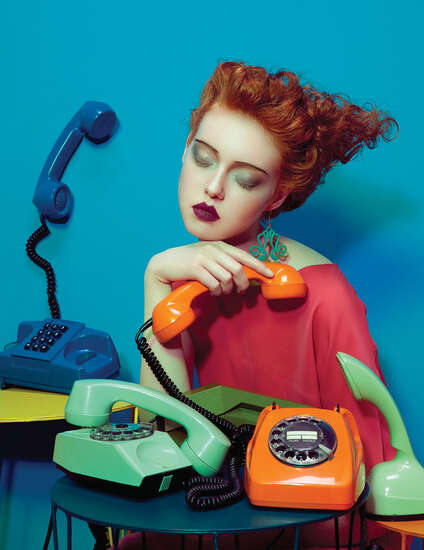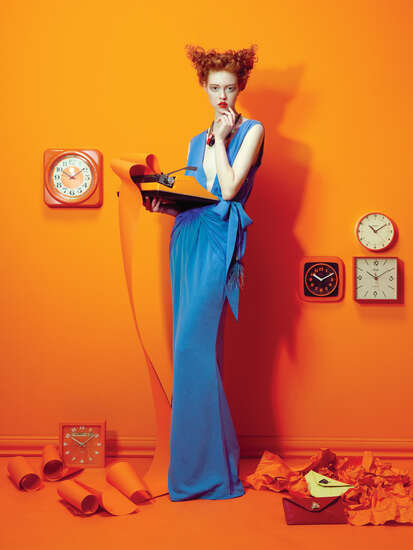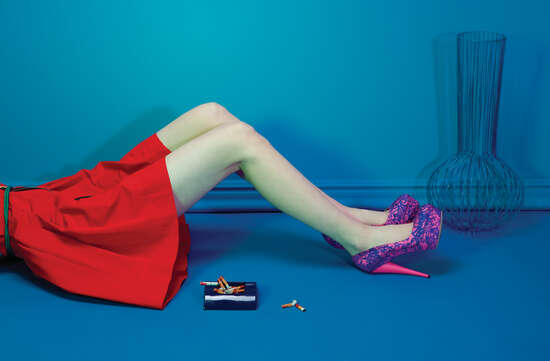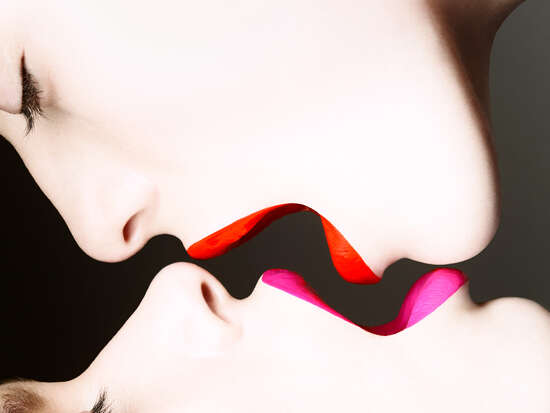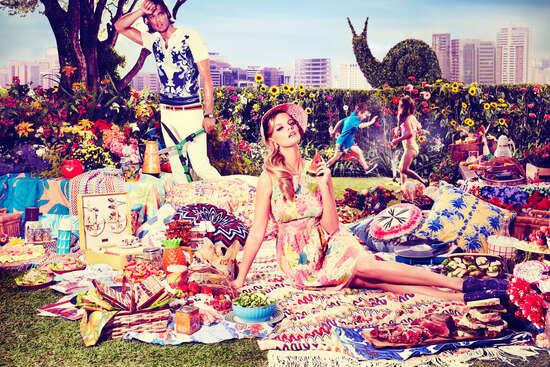READY TO HANG
Out of the box, all LUMAS artworks are ready and easy to hang.
SECURELY PACKAGED
LUMAS works are always packed to the highest standard to make sure it arrives as perfectly as it leaves us.
ARTIST SUPPORTED
Your purchase supports the free and independent work of your favorite artist.
14 DAY RETURNS
Easy 14 day returns to make sure you are satisfied with every purchase.
BACKGROUND INFORMATION
“Static glamour photography does not interest me – the complexity of the feminine identity does,” says Lucia Giacani. The artist usually sets in mostly surreal environments, makes objects float, and plays with oversized elements. This is her personal version of the modern woman, accentuated with a touch of irony.
In her series Killing Time, Giacani depicts a woman who meets every challenge at once while exuding a high degree of strength and beauty. She takes multiple telephone calls simultaneously and maintains her graceful composure.
This unique visual language exhibits parallels to that of Giacani’s role model, American artist Francesca Woodman. Much like Woodman’s provocative or even dramatic depictions of female bodies, Giacani makes the set a stage for extraordinary phenomena. In both artists’ work, the subjects find themselves in surreal surroundings that walk the line between lively and alienating. Giacani is a master of subtle imagery, transforming fashion icons into complex, highly aesthetic characters.VITA
Italian fashion photographer Lucia Giacani studied Design in Rome before coming to specialize in fashion photography. Her work has appeared in publications such as Vogue, Vanity Fair, and L’Officiel, and she has featured in exhibitions including Art Basel Miami Beach in 2014 and DXB Fashion Photography Fair 2015 in Dubai.INTERVIEW
THE COMPLEXITY OF FEMININE IDENTITY
Fashion photographer Lucia Giacani’s work has appeared in publications including Vogue, Vanity Fair and L’Officiel.
Who or what got you started with photography?
Growing up in a small town in central Italy called Jesi, I often stole my father’s camera on the weekends. My friends and I would go out of town to the hinterlands to find abandoned buildings, farmhouses and industrial complexes. We would dress up, pose, act stupid, be artistic, take photos and have fun.
How would you describe your work to someone who has never seen it?
My style is clean, feminine, strong and complex, so I would describe it as photography of female characters inhabiting often surreal or abstract worlds. Most of my works contain a progression, they tell a story or at least create a personality. Static glamour photography does not interest me – the complexity of the feminine identity does.
Tell us what it’s like to always work with stylists, models and designers. What is the collaborative process like?
Everything is thought out and preconceived for my shoots – mentally and on paper. I know exactly what I want to do. My ideas for the photos spring up spontaneously, but I am inspired by various sources such as other artists, films, photographers, dreams and my life experiences. After I have created my storyboard and the mood, I think about the best team for staging this vision – a stylist to choose the wardrobe and the accessories, a set designer or prop artists to create the scenery. At this point, a lot of work is done by my partner, Max, who helps with his creative input.
How do you select your models? Are there certain criteria?
There is an art to choosing the right model. The model is generally selected during a casting call in my own studio. I just follow my instincts, but I have a proclivity for pale redheads with irregular faces.
How would you describe the mood during the shoot?
I treat everyone on the set as a friend and try to create a smooth, relaxing atmosphere. Usually it is an enjoyable experience for everyone involved. During the shoot, the models may need some guidance to understand what their role is and what I want from them. They are young girls, and sometimes it requires patience – but generally models are hardworking, independent women.
How much equipment do you typically bring to a photo shoot?
For a commercial job, all the equipment is rented, so I only bring my sketches, my laptop and a pencil. When I work on a personal project, I shoot in my own studio. My preferred brands are Canon and Broncolor for the digital and lighting equipment. I always arrange the lighting plan beforehand, keeping everything to a practical minimum. Most of my early work was produced with four 400W lights – it’s effective if you know how to set up your camera.
What were your biggest struggles when you first started your career? Did anybody help you?
I have to smile when I look back and think about all the struggles and all the time and energy I put into my work. I still do that today. The financial side of things was pretty grim back then: Everything had to be borrowed since magazines did not provide me with a budget. However, this was a great creative experience in my early days – it was about a group of people who shared a common vision and trusted in each other’s ability to do a great job. In such moments, the struggle becomes a passion.
Taking all your experiences into account, is there a moment that you will never forget?
The shoot that will remain in my heart forever is my first job for Kult magazine. It was my first proper editorial fashion shoot in Milan. Since I always organized these by myself, I borrowed a van from my local mechanic and drove to the city. The shoot took place in a massive, empty industrial unit and I used broken down furniture from my grandmother’s house as props. Kult magazine had commissioned the work on the basis of my artistic black and white photography. I still thank them for taking a chance on trusting a young artist.
Who else was involved in the shoot for Kult magazine?
Aaron Henrikson was the makeup artist; he now works for Madonna. Dinalva Barros, with whom I would later collaborate for Vogue Accessory, was the stylist. The hair stylist, Giovanni Erroi, prepared the model along the concourse of a local train station. The model was perched on a piece of luggage when two policemen tried to stop us under the pretense that we were itinerant hairdressers – but I assume they only wanted to chat with the model.
What photographers from the past or present have influenced you the most?
Definitely Francesca Woodman, an American photographer who is renowned for her black and white photography and her artistic short films. She was a great artist and one of the main reasons why I picked up a camera in the first place.
What makes a great photograph?
It is a very hard question because ‘greatness’ can be highly personal. I will try to explain my thoughts in another manner. Let us just pretend that I am a painter. No one discusses the make of brushes used by great painters such as Rembrandt or De Kooning, so I am not a tech-fetishist. Although it is important to have a good ‘photographic eye’, it is not only about framing and composition. There is so much more! A photographer has to understand the use of light and its technicalities, the pose and disposition, the semiology and colour theory. But even with all these skills, the most important thing is understanding the art of communication.
In your opinion, what does a great picture communicate?
The pictorial language is more immediate than the verbal or written word, but no less complex. A photographer must instinctively know that a certain image can provoke certain feelings. When these emotions are transmitted and received in their purest form – like a big ‘Bang’ or a whisper – then you know that you are creating something special.
This interview with Lucia Giacani was conducted by LUMAS Curator Heike Dander.


